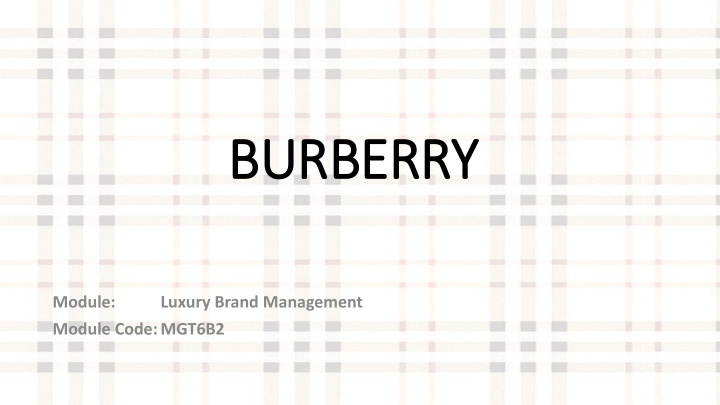



BURBERRY Module: Luxury Brand Management Module Code: MGT6B2
Burberry Brand History • 1856 – Brand established by Thomas Burberry • 1880 – Developed a waterproof material called Gabardine • 1901 – Introduced the Equestrian Knight trademark • 1924 – Check print made public The red, white, beige and black check pattern symbolises the brand The print was used as lining for the trench coat By 1967 the brand expanded their check print to other merchandise The brand became saturated with counterfeit items, the print started to look “cheap” The new CEO made the brand to a produce more quality pieces and less merchandise with the print.
Burberry Brand Id Identity Constructed source Physique Personality • High-end quality • Classic • Users acquire a look of casual • Sophisticated sophistication • Check pattern • Recognisable by distinctive Equestrian Knight logo and endorsement by celebrities Externalisation Internalisation Relationship Culture • Connectivity through extensive use of • British sensibility • social networking platforms Strong international recognition • Focus on relationship building • Flagship stores with high quality service Reflection Self image • Wealthy and accomplished • Affluent • Fashion conscious • Elegant and stylish • Globalised Constructed receiver Kapferer’s (2004) luxury brand identity model
Burberry Brand Personality Brand personality Modernity 30 25 20 15 10 Strength Eccentricity 5 0 Modernity: Timeless, everlasting, peaceful, balanced, charismatic Eccentricity: Respected. Down-to-earth, solid, decent Opulence: Prestigious, wealthy, glamorous, prominent Elitism Opulence Elitism: Cool, elegant, accomplished, flawless Strength: Karl Heine’s (2009) luxury brand personality model Resolute, direct, ambitious, successful, purposeful
Burberry Brand Positioning Price/accessibility Ease of Access • Channel 10 Luxury- • Gucci limited distribution 9 • Giorgio 8 Armani 7 • • Burberry Miu miu 6 • Just Cavalli • D&G • Hugo Boss 5 Sporty Casual Fashionable Classic Couture 4 • Polo 3 Ralph Lauren 2 1 Premium- wider 0 distribution Accessories Thomas Blue Label Black Label Burberry Prorsum (perfumes, Burberry London timepieces, eyewear) Ease of Access
SWOT Recommended Growth Strategy Strengths: • Wide international network of retail, wholesale and licensing channels • Granted royal warrants by Prince of Wales and Queen Elizabeth II • One of the largest luxury fashion brand in the UK • Current Products New Products Strong advertising and brand presence in UK and Europe • International celebrities as brand ambassadors • New Markets Current markets Inaccessible to working class, exclusive Market penetration Product Development Weaknesses: • • Intensify online social media events to Intensify non-apparel development • • History of negative association with ‘chavs’ and football hooliganism increase consumer participation and e- Appoint new, young designers • commerce activities Increase endorsements by famous • Weak cost structure • 3D screening of fashion shows in emerging celebrities, especially those • Lack presence in particular areas of the world markets which have less opportunities for representing emerging market such shows to be run in their countries cultures Opportunities: • • Increase the efficiency of supply chain Licensing of new accessories • Expansion and growth into emerging markets processes • Increase retail stores in small cities • Increasing use of e-commerce • Increase accessibility of diffusion products such as accessories • Hosting more fashion shows • Increasing celebrity endorsements • Increasing sponsorship for events Market Development Diversification • Increase innovation for new products/services • • More flagship stores and regional offices in Horizontal integration- form joint Threats: emerging markets such as Middle East, India, ventures or contractual relationships China, Sao Paulo, Armenia, Mongolia, Egypt, with other luxury industries such as • Intense competition, high bargaining power and low switching costs for Israel high end sports cars to produce their customers • Vertical integration-acquire textile industries merchandises • which supply Burberry with raw materials Substitute products • Acquire close rival companies such as D&G, • Pricing pressure Hugo Boss • Threat of negative associations • Insufficient stores (brand presence) in smaller cities
References Ansoff, I. (1957), Strategies for Diversification, Harvard Business Review, 35(5), pp. 113-124. Heine, K. (2009), Using personal and online repertory grid methods for the development of a luxury brand personality, The Electronic Journal of Business Research Methods ,7(1), pp. 25-38. Kapferer, J. N. (2004), The new strategic brand management: Creating and sustaining brand equity long term , 3 rd edition, London, UK: Kogan Page Porter, M. E. (2008), The five competitive forces that shape strategy, Harvard Business Review , 86(1), pp. 78- 93. Truong, Y., McColll, R., and Kiitchn, P. J. (2009), New luxury brand positioning and the emergence of Masstige brands, Journal of Brand Management , 16, pp. 375-382.
Recommend
More recommend